
Are you writing content for your website and struggling to rank? What about using long-tail keywords? This type of keyword is going to demand more of our focus due to the changes we’re seeing in technology.
The global amount of searches each day is staggering and ideally, you are wanting to be on page one of Google (or any other search engine) to be found quickly. Keywords are necessary to reach your desired audience.
But what’s a long tail keyword? And why are they important for your digital marketing strategy?
This type of keyword is very effective for online marketers. It helps zero in on those customers who:
- Have a credit card in hand, ready to purchase.
- Reaches those who are using voice search.
And if you’re trying to focus on free traffic, also known as organic search traffic, it’s important to have our content land on page one of Google.
We’ll look at what long-tail keywords are, how to find them, and where to place them in your content.
If you’d just like to see where I learned to succeed online, come and meet me here!
Contents
What’s A Long Tail Keyword?
Long-tail keywords are those longer, 3-4 word phrases, which are much more descriptive. They tend to be used by someone who is closer to the point-of-purchase.
In other words, they know exactly what they want, so type in that exact description. These people are much more likely to convert to a sale.
Let’s take a look at a customer’s purchase lifecycle:
- The Research Phase
This is the beginning phase when the customer has some sort of pain point and they are searching for a solution. They don’t have a product or service in mind yet but are “learning” through different mediums like T.V., magazines, Facebook, Google searches, etc…
These days, the majority of people go online because that’s the one place that has all the answers, right? And this is when they start to look at what type of products or services will help them.
As far as keywords go, they are typing in one or two-word searches and bringing up a vast amount of information to sift through. They aren’t ready to buy yet. It’s just research!
- The Consideration Phase
In this phase, the customer has decided on a solution and is comparing the products available, such as price, features, etc.
They are ready to purchase but are looking for those products that will give them the most relief. Everyone wants the most for their money.
They will be using keywords such as review, comparison, or even scam.
- The Decision or Purchase Phase
Now their minds are made up and they’ve taken out their credit cards. All they’re looking for now is the best deal for the most benefits.
This is when they are typing in those “long-tail keywords”. For instance, instead of searching for “road bikes”, they’re typing in “Ridley X-Road A60 Bicycle”.
From a marketer’s point of view, these tend to be the “unpopular” keywords, because they have a much lower search volume. They are also referred to as “low hanging fruit”.
Lower search volumes, yes. But a much higher chance of a conversion.
Would you rather have 100 visitors and 1 sale or 20 visitors and 10 sales? Just sayin…
Let’s look at another example. Say your business specializes in “Nike running shoes”. If you use the keyword “Shoes” you will not rank on page one due to the enormous competition of that keyword. And you would be competing with huge companies like Nike or Addidas.
Surprisingly enough, this very competitive keyword only gets 10 to 15% of all searches.
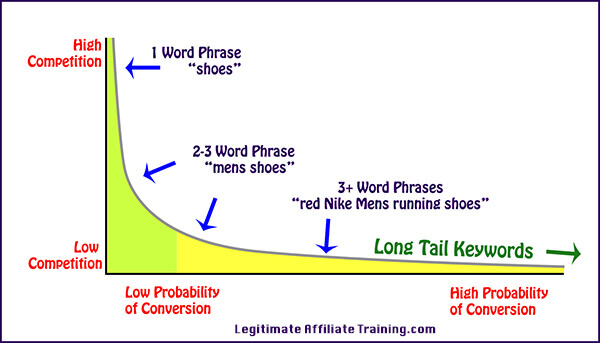
Mid-length keywords like “Men’s Shoes” have a little less competition and account for another 15 – 20% of all searches.
These keywords have very little competition because the phrase is so descriptive, yet result in about 70% of all online searches. Wow!
When you use a long-tail keyword such as “Red Nike Men’s Running Shoes” you will reach your targeted audience who have already spent time researching various types of running shoes and have decided on this style. They are ready to make the purchase.
So even though you’ll receive less traffic, you’ll be receiving traffic that’s ready to convert. Now its time for you to show them all the benefits of buying from you, and you’ve made a sale.
What Do You Mean “Changing Technology”?

Every year, we see more advances in the technology we use. Especially the smartphone. As the percentage of mobile online shopping increases each year, our campaigns need to be modified for both mobile screens and the way the search is done. I’m talking about voice search.
Voice search is the fastest-growing type of search. It allows you to be hands-free and multi-task. And rarely do we type the way we speak.
When typing in a search, we often use a shorthand style such as “weather Toronto”. But when we speak, we’re more likely to ask a complete question such as “what’s the weather like in Toronto?”
As programs like iPhone’s Siri are increasingly refined and used, search engines like Google have been refining their programming to adapt to the natural phrasing of voice searches.
So what does that mean for our online businesses? It means we need to incorporate a voice search strategy to our websites because I believe this is the future of SEO.
We need to focus our attention on a more conversational tone in our content and using longer keyword phrases or long-tail keywords.
How Do They Help Me Rank?
You will rank for three different reasons.
#1. Competing with Fewer Web Pages
Ranking with long-tail keywords tends to be easier than with a single word keyword, because of less competition.
Take a look at what my keyword research tool, Jaaxy, came up with when I typed in “Shoes”…
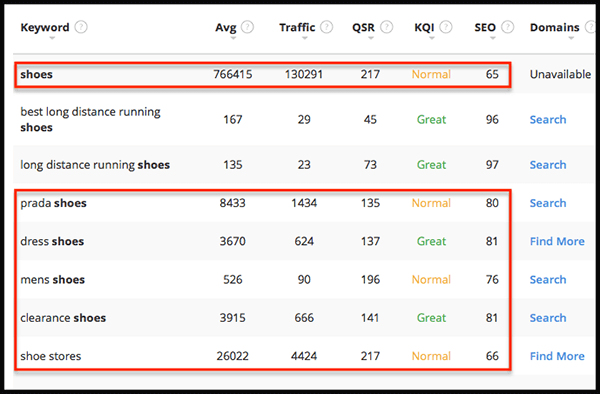
This tool shows you there are over 760K searches per month, which is great, but look at the competition. There are 217 QSR (ranked webpages) ranking for the same keyword. And your SEO chances of ranking are only 65 out of 100. Not great at all.
Even the two-word keywords have a lot of competition. So unless you have a lot of authority in the shoe niche, like Nike or Addidas, you don’t really stand too much chance of ranking.
Now check out when I type in “Red Nike Men’s Running Shoes”…
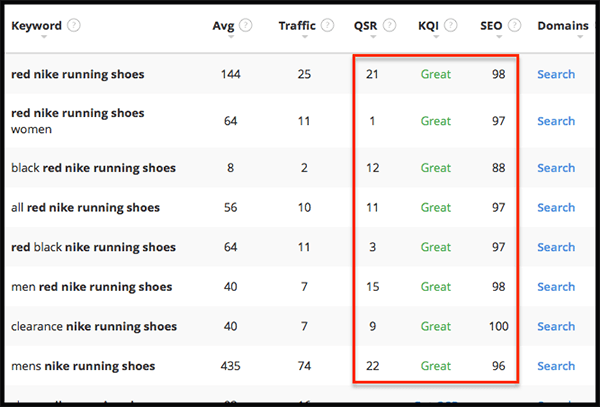
Yes, the search number has dropped, but so has the competition. And look at the SEO metric. Your chances of ranking on page one of Google is very high.
With a higher ranking, comes more visibility. And more visibility means more people will find you. And remember when I said that these people are ready to buy….? Ka-Ching!!
Now, look at all the other long-tail keywords you could rank for as well. This brings me to my second point
#2. Creating More Unique Content
See all the different combinations of long-tail keywords there are? That gives you the opportunity to write many more articles to reach the searchers using all those different phrases.
And the good news is “Google loves content”. Google will rank those sites with more content higher than those who have little.
But remember, Google likes unique content offering value.
This all leads to your domain authority (which is another article, lol). But basically, as long as you’re writing many unique, and valuable pieces of content, you’ll be rewarded with better ranking.
Want to know the cherry on the cake? You can even outrank the competition this way. With using a long tail keyword SEO strategy, you can actually overtake them. They may be selling the same Nike shoe, but your descriptive keyword phrase can attract more customers.
#3. Providing More Context
Ever since Google has come out with it’s 2017 Hummingbird Update, their algorithms search for more exact phrasing as well as the meaning behind the words.
I know…artificial intelligence…yikes!
So the use of long-tail keywords helps to describe what your article is about. It shows your readers that you’re providing real value, which is ultimately what Google is looking for.
This is the key to writing successful content. Providing value! You may want to read “What is Content Creation“.
There’s No Substitute For Research!
There’s just no way around it… finding your long-tail keywords takes research. You must decide which phrases are worth using. You want sufficient search traffic, yet that promising low competition number.
Start by using more specific descriptions of your services or products, like in my example of Nike shoes. Another way is to use the 5 W’s in a question format.
Let’s try another example…
If your business sells designer baby furniture, some long-tail keyword examples could be:
- Who sells designer baby furniture?
- What is designer baby furniture?
- When is the best time to buy designer baby furniture?
- Where can I buy designer baby furniture?
- Why should I buy designer baby furniture?
The next thing you need to do is research these ideas using a keyword research tool, to determine if they will be usable. You want to use keywords with little competition to have success at ranking on page one.
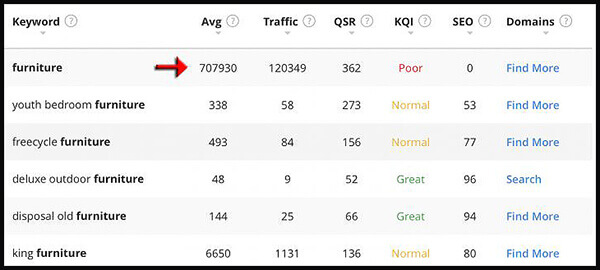
As you can see, the keyword “Furniture” is much too competitive and should be avoided. It shows a monthly search volume of over 700K, which is great, but you’ll have to compete with 362 ranking web pages using that exact keyword.
The keyword quality indicator (KQI) also tells me it’s a poor choice with a 0/100 chance of getting ranked.
Instead, let’s type in “What is designer baby furniture”. It’s one of the 5 questions above…
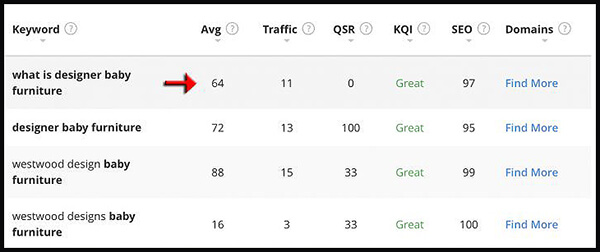
Well, look at that! It shows 64 searches per month, but with 0 competition!!. This choice has no competing websites and shows me I have a 97/100 chance of ranking on page one.
Now, in this case, the search number is fairly low. So I would recommend you keep researching. This is also why having a powerful tool like Jaaxy is so important.
My ideal choice for “low hanging fruit” is to find a keyword phrase that has about 250 search results per month and less than 50 competing web pages.
You can then go on to search all the other questions we came up with above, along with all the other ideas the keyword tool gives you, and you’ll have many content ideas to reach your targeted traffic.
How LongTail Keywords Can Boost Your SEO
Before Google’s many algorithm changes, you could get great ranking with an article stuffed with keywords. Not anymore! Google will not rank you if you do this, because they assume you are spamming.
Instead, your article needs to make sense, sound conversational, and offer value to your reader.
According to Moz, these are the primary locations to put your keywords for maximum SEO juice.
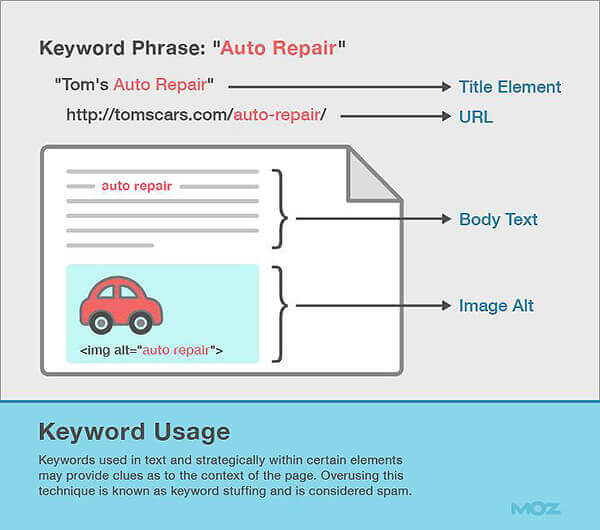
The ideal places for your long-tail keywords are:
- The title of your article.
- The meta URL and meta description.
- Within the first paragraph.
- The alt text of your pictures (where it makes sense).
- In an H2 to H6 subheading.
Which Keyword Tool Should I Use?
There are many tools online for you to access. You would need to spend some time researching these tools to find one you’d like. For keyword research, you want a tool that provides you with the necessary metrics to make an informed decision.
- The number of monthly searches.
- The amount of competing web pages.
- A keyword quality indicator.
- The readability of the phrase (does it make sense).
Many online keyword tools offer you a lot of metrics that aren’t necessarily needed for your purposes. They are legitimate tools, but are designed for other needs and can be quite expensive or have a steep learning curve.
One such tool is called “Semrush”. I’ve written a review on Semrush if you need more detail.
I would like to save you some time and show you what I use. It’s called Jaaxy and it gives me the data I need easily and quickly.
I made this video, using a different example, to show you how I use it.
Jaaxy offers you the above metrics, and other time-saving options like saved keyword lists, alphabet soup method of finding long-tail keywords, search analysis and more. And best of all you can try it for free!
This tool was designed by two successful online marketers who also designed an incredible teaching platform to help new people learn the proper way to start an online business. And Jaaxy is integrated into the platform and free for all members to use.
Ultimately, you need a research tool because they provide you with:
- Easier ranking opportunities.
- Which in turn gives you higher sales conversions.
All of which will certainly lead to a much more profitable bottom line! Isn’t that what all marketers are wishing for?
You can certainly become a Jaaxy member, but why not try out the entire training platform? You can start for free, and test drive the training, all the tools (including Jaaxy), and meet the amazing community.
Trust me, there’s nothing so all-inclusive as this platform.
Click on the image below to read all about it. And when you join, I’ll greet you on the inside, and help you as much as you need me to. See you soon!
So are you ready to start your road to success? Long-tail keywords are the best way to optimize your content writing and blogging.
If you have any questions or comments, please leave them below. I’d love to hear from you.
Your friend,
Suzanne


Thanks for the great keyword research ideas, Suzanne!
I definitely have a problem with finding the so-called “buyers keywords” even though I have managed to find a lot of low competition informational long tail keywords. These are good for getting your content ranked in Google and getting some traffic but they won’t generally convert for me.
This is something I have to work on and I will definitely put your tips here to use!
Hi and thanks for your comment.
I feel your pain, lol. It can be a delicate balance. I find that the more descriptive the keyword phrase, and with enough monthly searches, the better chances I have at conversion. Low competition is great, but you need those monthly searches too.
And of course, a lot has to do with the domain authority of your website. If you’re just starting out, and Google hasn’t given you that higher-ranking yet, you’re struggling anyway. Keep on writing articles, and soon that traffic will turn around and you’ll get many more buyers searching you out!
Best wishes to you,
Suzanne
This is a great start for me.
I’ve been struggling with getting traffic to my website and the keywords I’ve been using just don’t seem to be doing it for me.
I’m going to take your advice to hand and see if I can turn my online business around.
Thanks for sharing.
Hi Joe, and thanks for commenting.
It’s always a struggle to get more traffic, isn’t it? That’s why strategies like these help so much. You won’t see a big jump in traffic overnight, but over time it really helps. And it’s so much easier to rank.
If you need any more help, let me know!
Cheers,
Suzanne
Great article and tutorial on what exactly is a long tail keyword.
I like to go a little bit deeper with these fab keywords and check out the competition on page 1 of Google.
If they are all sites with high domain authority, I may not use them. If the strength of the competition is just too strong to rank for that keyword phrase, I feel like the time and effort to create content isn’t worth it for me.
Hi Derek,
I understand your thinking, but for the sake of helping my beginner marketers, it’s still a much better chance to rank than using a broader term.
I believe that choosing keywords with very little competition is better overall for ranking. And as time goes by, and your site starts to increase its own domain authority, your ranking will improve for this content.
Thanks for commenting,
Suzanne
Hi, this was a very interesting and educational article!
Yes, it can be done so easily. The mysterious long tail keyword explained in a simple way. So many of us who read this will probably benefit from this.
So you only settle for the long tail keyword that gives a search volume of at least 250? I find quite a lot of good keywords between 50-150, not so many over.
If you have more pictures, do you also have your keyword in all the pictures unless it is out of context? And it is only under “alternative text” you write it in the picture?
If I understand correctly, the keyword should be used in both the meta title and meta description.
In addition, should it be used in the title itself and repeated at the beginning of the article, and inserted into relevant pictures?
I’m a little tired, so sorry if I repeat myself 🙂
But thanks for the great article and video!
Hi Erlend, and thanks for the awesome questions!
I don’t only settle for keywords that have a 250 search number. I said that’s my ideal choice, lol. I wish they could all be there, but alas, no. I use lower searches as well. They are much more common, but when I find that perfect one…I jump on it, haha.
For your images, it depends how long your article is, and how many images you have. If your post is under 2000 words, I’d be careful not to use the exact keyword phrase too many times, or it’ll look like spam. I will use it in one or two, and then use LSI keywords in the remaining images. Try using this free tool… LSI Graph It works great for those alternate keywords that Google is looking for.
I put my keyword in the article title, in the first paragraph, the first image, sometimes the first H2 heading, and the meta title and meta description. The “meta” area should be at the bottom of your page, in your “AIO Seo” area, or “Yoast” area. And if you don’t have an SEO plugin, I highly recommend All In One SEO. It’s the plugin that Google prefers!
I hope this helps, and please feel free to ask more if you need additional help, ok?
Cheers,
Suzanne
It’s so interesting that long tail keywords are easier to rank for AND you get the most conversions out of them. You’d think the harder ones have better conversions, so it seems like a no-brainer to use long tail keywords for maximum traffic and profits. I’ve been using long tail keywords in my title and first paragraph but going to start using them in my alt tags and meta description. Hope this helps with rankings. Thanks for the help
Hi Hazy,
People might worry about lower monthly searches, but considering those searches are from people ready to buy, it’s a much more productive way to go. And yes, using your alt tags and meta description for additional keyword placement helps your SEO without overstuffing your articles with keywords.
Best wishes,
Suzanne
Hi Suzanne, What a great post. So informative and helpful. Thank you so much this is going to be a tremendous help.
Hi Jill, and thank you!
I believe long tail keywords are much more effective for our SEO strategies. The more refined, the better chance to get a customer that is ready to make a purchase. And of course, that’s the type of customer we all want for our businesses…:).
Blessings,
Suzanne
I am a big fan of Jaazy and long tail keywords is huge if you want to get consistent traffic coming to your website.
It is much easier to fly under the radar and land on page one of google for long tail keywords and since these keywords are so specific, the prospect that lands on your website is warm and not cold – practically ready to buy.
I like your idea about a voice search strategy. I do believe that is the wave of the future. Our goal should always be to make the prospects experience on our websites user-friendly.
I will definitely keep this to refer to. You have some great nuggets of information here.
Thanks so much Nate. I believe we need to change with the ebb and flows of technology to remain successful. And long tail keywords are definitely the way to go.
Blessings,
Suzanne
This is a pretty interesting concept to me. I would have though the search engines would to some extent randomize who shows up at the top to give different websites a try and see if newer ones show better content than older ones. But this makes sense to hunt for less competition.
At what number of words do you stop looking? Is there a magic rule where when the keyword is 8 words long you shouldn’t bother anymore?
Hi Craig, good question! There’s no magic rule. You just want an accurate, readable description of your product. Once you’ve got that, type it into Jaaxy to see if there are any searches. If you have too many words with no searches, then shorten it accordingly. Jaaxy will let you know when you have searches with low competition.
I hope this helps you,
Suzanne
Such an informative article. People are searching solutions for their problems with long tail keywords a lot more than they use to, and it’s only going to grow even more in the upcoming years. The fact that you highlight and show us how to use the Jaaxy tool makes it much easier for me to know how to use it myself. Thanks a lot!
You’re welcome Brandon. It’s a great tool. I use it everyday. It can be very addicting haha.
Cheers,
Suzanne
Hi Thank you very much for the information. I am new on online marketing. It is the first time I heard of Long Tail KeyWords. The information is useful for my online marketing plan. In order to success online business, we need to pay attention to long tail keywords, since these words lead to sales more effectively than short keywords search, which is mostly for formation. Is my thought right?
Hi Anthony,
Yes you’re correct. Short keyword phrases (1 or 2 words) are too broad. There’s a good chance you won’t rank very high with Google because of so much competition. People use these keywords when they are just starting their research. When they’ve decided what they want to purchase, they will type in a descriptive long tail keyword to find exactly what they’re looking for. Best wishes on your new business!
Cheers,
Suzanne
Hi Suzanne, I like the idea of low hanging fruit, it makes a lot of sense. But I have a question for you. What is “The alphabet soup method?”
Hi Keith, and thanks for asking. The alphabet soup method is typing your keywords into Jaaxy, then it goes through A to Z by adding words before and after to lengthen the phrase. For example, if I put in “long tail keywords”, with the letter “a” you would see “what are long tail keywords, or with “y” you might see “long tail keywords and why you should use them”. It’s a great tool to come up with ideas. I hope this answered your question.
Blessings,
Suzanne
Oh wow! I have been experimenting with this method and it’s awesome. I would have never thought of this on my own. Thanks Suzanne!
That great Keith!! Have fun finding lots of gems.
Blessings,
Suzanne
That great Keith!! Have fun finding lots of gems.
Blessings,
Suzanne